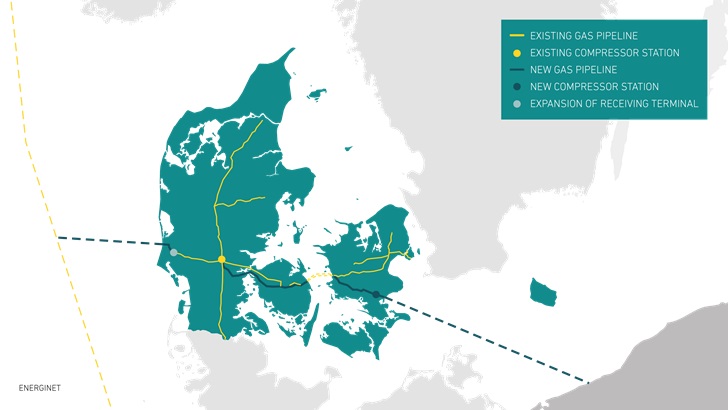Firms Approve Pipeline to Supply Norwegian gas to Poland
Polish and Danish gas grid operators Gaz-System and Energinet said they have agreed to finance construction of the Baltic Pipe project, a 560-mile (900-km) pipeline that will reduce regional dependence on Russian supply by transporting Norwegian gas to Poland via Denmark.
"The construction of Baltic Pipe will not only benefit consumers in Poland and Denmark but will also be beneficial to both countries," said Thomas Egebo, CEO at Energinet, Denmark's gas transmission system operator.
"The new gas interconnector will further strengthen and integrate the European gas market. Moreover, Baltic Pipe may contribute to achieving European climate goals," Egebo added. "In both countries the dialogue with the many landowners and authorities will continue so that the Baltic Pipe project can be implemented with as little impact on people and environment as possible."
Costs of the project, which will cross the territories of Denmark, Sweden and Poland, are projected to range between $1.8 billion and $2.4 billion (1.6 billion to 2.1 billion euros). Gas transmission is expected to start in late 2022.
In addition to transporting Norwegian gas through Denmark to Poland and other countries in the region, Baltic Pipe also will enable reverse transmission from Poland to Denmark and Sweden, its developers said.
At a news conference in Warsaw, Polish Energy Minister Krzysztof Tchorzewski described Baltic Pipe as part of the North-South Gas Corridor, a project to link Poland to an LNG terminal in Croatia, via the Czech Republic, Slovakia and Hungary, Reuters reported.
Energinet and Poland's Gaz-System said the Baltic Pipe project consists of five main components:
- Gas pipeline on the seabed of the North Sea, which will connect Norwegian deposits with the Danish transmission system;
- Expansion of the Danish transmission system, which will increase gas transmission capacity and lower the average cost of the transfer;
- Modern compressor station in Denmark, which will enable secure gas supply to Poland as well as via reverse flow to Denmark;
- Gas pipeline on the seabed of the Baltic Sea – the bidirectional connection of the Danish and Polish transmission systems diversifying the supply sources and directions;
- Expansion of the Polish transmission system constituting a further step to make Poland a regional gas hub, which will reduce the risk of supply disruptions and boost the national economy.
Norway meets about a quarter of Europe's natural gas needs and is the second largest supplier after Russia. Most of its deliveries are via a network of offshore pipelines to Britain, Germany, France and Belgium. Norway's Gassco said the Baltic Pipe project provides another export point but is not expected to affect export volumes.
In 2015, Poland opened its first LNG terminal on the Baltic Sea as part of its efforts to diversify its sources of supply. Poland aims to expand the facility.
- P&GJ staff and Reuters report
Related News
Related News

- Enbridge Plans 86-Mile Pipeline Expansion, Bringing 850 Workers to Northern B.C.
- Intensity, Rainbow Energy to Build 344-Mile Gas Pipeline Across North Dakota
- U.S. Moves to Block Enterprise Products’ Exports to China Over Security Risk
- Strike Pioneers First-of-Its-Kind Pipe-in-Pipe Installation on Gulf Coast with Enbridge
- 208-Mile Mississippi-to-Alabama Gas Pipeline Moves Into FERC Review
- U.S. Pipeline Expansion to Add 99 Bcf/d, Mostly for LNG Export, Report Finds
- A Systematic Approach To Ensuring Pipeline Integrity
- 275-Mile Texas-to-Oklahoma Gas Pipeline Enters Open Season
- LNG Canada Start-Up Fails to Lift Gas Prices Amid Supply Glut
- Kinder Morgan Gas Volumes Climb as Power, LNG Demand Boost Pipeline Business





Comments